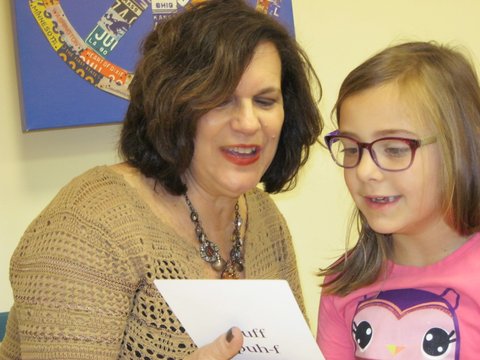Childhood Apraxia of Speech (CAS)
Childhood Apraxia of Speech is a speech disorder of motor programming and planning that affects a child’s ability to develop and produce intelligible speech. CAS causes a child to have difficulty in voluntarily planning, producing and sequencing the movements needed for speech. Children with CAS may have associated problems in the areas of language and academics.
View our other approaches:
- Apraxia of Speech (CAS)
- Articulation Disorders
- Auditory Processing Disorders (APD)
- Autism Spectrum Disorder (ASD)
- Deviate Swallow (Tongue Thrust)
- Executive Functions Deficits
- Expressive-Receptive Language Delays/Disorders
- Feeding Disorders
- Fluency (Stuttering)
- Oral Motor Disorders
- Phonological Disorders
- Social (Pragmatic) Communication
- Voice and Resonance Disorders
Speech characteristics of childhood apraxia of speech may include:
- Unintelligible speech
- Difficulty positioning the articulators for speech sound production
- Difficulty with speech movements
- Instability and inconsistency of speech productions
- Difficulty speaking “on demand” or under even minimal pressure
- Unusual and atypical error patterns
Developmental signs of childhood apraxia of speech may include:
- Slow and late development of speech skills
- Limited early phonological development
- Limited ability to imitate speech
- Frustration with communication skills
- Good communicative intent
 Our treatment approach to CAS incorporates the principles of motor learning.
Our treatment approach to CAS incorporates the principles of motor learning.
Our therapy protocol emphasizes speech movements and syllable shapes, uses cues and prompts as needed, addresses prosody skills, provides appropriate feedback, and applies functionality to speech targets. Our comprehensive treatment approach is in accordance with the American Speech-Language–Hearing Association (ASHA) and the Childhood Apraxia of Speech Association of North America (CASANA) best practice protocols.

The Kaufman Speech to Language Protocol (K-SLP) is a method of teaching children with apraxia of speech the easiest way of saying words until they have increased motor-speech coordination. The Kaufman Speech to Language Protocol teaches the shell of words, without including the complex consonants, vowels, or syllables which make a word too difficult for the child to attempt. This teaching method is a reflection of how young children produce “first words”. The K-SLP provides children of all ages with a way to attempt difficult words using word approximations, and refines and reinforces these attempts toward whole target words and phrases.
Prompts for Restructuring Oral Muscular Phonetic Targets (PROMPT) is a tactile-kinesthetic approach for treatment of motor speech disorders that uses touch cues to a child’s articulators (jaw, lips, tongue) to manually guide the child through a targeted word, phrase or sentence. The PROMPT technique develops motor control and the development of proper oral muscular movements, while eliminating unnecessary muscle movements, such as jaw sliding and inadequate lip rounding. The speech-language pathologist helps the child correctly produce a phoneme by stimulating these through touch.
Sounds In Motion is an evidence-based interventional program designed to develop listening skills in children, which in turn helps to improve articulation, vocabulary, auditory memory, phonetic awareness, and early literacy. The Sounds In Motion approach pairs kinesthetic gross motor movements with phonemes to teach articulation, phoneme awareness and sound/symbol association. It helps children develop the ability to become actively involved in the task of listening.
Prosodic Facilitation treatment methods use intonation patterns (melody, rhythm, stress) to improve functional speech production. Using this approach, the speech-language pathologist guides the child through a gradual progression of steps that increase the length of utterance, decrease dependence on the therapist, and decrease reliance on intonation.
Tapping Cues/Pacing Boards which provide children with a visual, tactile and motor cuing system that helps them increase the clarity of their utterances. Tapping cues/pacing boards provide input for reducing rate of speech, sequencing sounds/syllables in multisyllabic words, and sequencing words in sentences. Tapping cues/pacing boards increase the child’s independence as they practice speech praxis exercises.
Integrated Phonological Awareness Intervention (IPA) is designed to simultaneously facilitate speech production, phonological awareness, and letter-sound knowledge in preschool and young school-age children. Specific approaches may include teaching nursery rhymes, focusing on sound properties of spoken language, and engaging in letter game activities.
Integral Stimulation is a method for practicing movement gestures for speech production that involves imitation and emphasizes multiple sensory models (auditory, visual, tactile). Movement gestures are shaped, beginning with direct imitation, moving to simultaneous production with tactile or gestural cues if direct imitation was unsuccessful, and then fading the simultaneous cue and again moving to direct imitation. The key element of this approach is that the speech-language pathologist is constantly adding or fading auditory, visual, and tactile cues as needed after each trial.
At Suburban Speech Center, our apraxia therapy program includes specific training to increase functional language in the home. Our speech-language pathologists will provide specific words and phrases to empower the child to attempt more speaking situations. The speech-language pathologist will then continue to refine and integrate the child’s speech-language skills.
Related Resource:
Childhood Apraxia of Speech Directory
Nancy Polow, Ph.D., C.C.C.-SLP
www.apraxia-kids.org
Nancy Kaufman, M.A., C.C.C.- SLP
Nancy Kaufman’s Speech to Language Protocol
www.kidspeech.com
